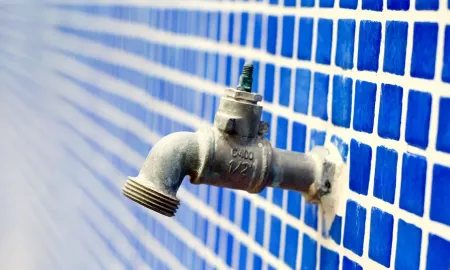While the heat might be very welcome for those of us who like to spend more time outdoors, it does also create the right conditions for bacteria, such as Legionella, to thrive.

An aquatic organism, Legionella is found widely in the natural environment, such as lakes, rivers and soil. It can also colonise man-made systems too. It is dormant at temperatures below 20°C, but as soon as the weather begins to warm, it could start to multiply, making the potential for Legionella growth in water systems much higher in summer months.
While the risk of Legionella growth is most commonly associated with water systems in buildings and fixed structures, it can also thrive within water systems on board trains. This is even more problematic in the new COVID era, where there has been an increase in working from home and a reduction in passenger footfall. This has led to an increased chance of water systems housing stagnant water, an environment in which Legionella bacteria are known to thrive. Consequently, it is important to ensure that on board toilet and hand washing facilities are correctly maintained and managed to prevent bacteriological contamination and lessen the risk of contracting respiratory illnesses such as Legionnaires’ disease.
Water systems installed on board passenger rolling stock pose additional problems, as they incorporate sealed cold water storage tanks which are not readily accessible, while in situ on the unit. The tanks can be mounted in the vehicle roof space where they might be subject to heat gain during warmer months. However, the same factors that affect water quality in fixed building installations also apply to those on board, which mean that the same regulations and guidance is relevant and applicable.
Where can Legionella be found on board trains?
When it comes to the risk of Legionella growth, passenger rolling stock pose a series of unique challenges, as each class of train will have a different build, manufacturer and individual design features to contend with. However, all contain similar features, such as a cold water storage tank, water heater, distribution pipework and tap/outlets. While there is no direct evidence of passengers or staff contracting Legionnaires’ disease as a result of using on board facilities, there have been numerous instances where Legionella bacteria have been found to be present within water samples taken from on board wash hand basins and catering facilities. This poses an increased level of risk when an aerosol is generated by the outlet, creating the opportunity for those using the facilities to inhale contaminated droplets.
What legislation applies to the control of Legionella on board?
While there is no legislation in the UK that specifically applies to the management and control of Legionella on board trains, train operating companies are subject to more generalised health and safety legislation that requires them to protect both personnel and passengers from a number of risks, including Legionella bacteria. Under the Health and Safety at Work Act 1974, Management of Health and Safety at Work Regulations 1999 and Control of Substances Hazardous to Health 2002 (COSHH), rail operators have a duty of care to protect the health and wellbeing of employees and members of the public against harmful Legionella bacteria.
There are also two key pieces of legislation surrounding the management and control of Legionella in standard water systems, with full compliance to both enabling rail operators to effectively minimise the risk of bacterial proliferation within on board water systems:
- HSE L8 Approved Code of Practice (ACoP) and Guidance on Legionnaires’ disease provides those responsible for controlling the presence of Legionella in water systems with guidelines on how to identify, assess, manage and control sources of risk. It stipulates that all Legionella risks must be identified and managed, while also recommending the regular monitoring and maintenance of water systems
- HSG 274 provides technical guidance on the management of Legionella risk in different types of water systems. Part 2: The control of legionella bacteria in hot and cold water systems is the most relevant for the rail industry with regards to on board water systems, outlining the monitoring and maintenance regimes and their frequencies required to ensure health and safety.
Why is it important for Legionella to be risk assessed, controlled and monitored regularly?
Although it is not possible to guarantee that any water system will be completely free from Legionella, the overall aim should be to reduce the level of risks by preventing the circumstances in which the bacteria thrive. Rather than adhere to a number of set requirements, the best approach to control the level of Legionella within on board water systems is to undertake risk assessments to identify where the bacteria are located, the level of risk that it poses and the mitigation measures required.
Furthermore, as part of the HSE L8 ACoP guidance, it is a legal requirement for employers to have an up-to-date, suitable and sufficient Legionella risk assessment for their water system. This requires responsible persons to identify any potential hazards, consider who may be at risk of exposure, keep records and implement and review control measures. A Legionella risk assessment should be carried out every two years or whenever there is a change in circumstances to ensure that it remains fully up-to-date.
Insufficient management, lack of training and poor communication are all contributing factors to the outbreak of Legionella on trains, which is why rail operators are also legally required to ensure that staff receive adequate Legionella Awareness training, allowing them to competently and confidently protect employees against a potential Legionella outbreak in the workplace. You can find out more about SOCOTEC’s Legionella risk assessments and training opportunities here.
What control measures can be implemented to control the presence of Legionella on board trains?
While there is no written requirement for the water dispensed within on board systems to be monitored regularly, it is strongly recommended that samples are tested on a frequent basis to ensure that the concentration of Legionella bacteria is consistently maintained below the level where action is required (as stated in HSG274 Part 2). To ensure that this is the case, rail operators should have a written scheme of control and appropriate control measures in place, as well as responsible persons appointed to manage the risk of Legionella within on board water systems.
With regards to Legionella on board UK passenger rolling stock, guidance specific to on board services is now given in Rail Delivery Group (RDG) Guidance Note RDG-GN013 – Control of Risk Posed by the Presence of Legionella Bacteria in On-train Water Systems (issue 3), issued in October 2019.
Having the appropriate control measures in place will allow rail operators to control the conditions in which bacteria can multiply, reducing aerosol generation and human exposure. There are a variety of mitigating measures that can be implemented across on board water systems, including:
- Temperature control – as Legionella bacteria thrives between 20 and 45 oC, small low volume hot water heaters such as those used within on board systems should produce hot water at a temperature between 50-60oC. Where the risk of scalding is controlled by blending the hot water with a cold supply, mixing valves should be set to provide water at the outlet between 38-44°C.
The temperature of hot water supplied by on board heaters and the temperature of blended water supplied from mixing valves should be regularly checked to ensure adequate heating.
Additionally, stored cold water should be kept below 20oC, hence cold water storage tanks – especially those located in the roof space of rail vehicles – should be sufficiently insulated against heat gain. Distribution pipework within rail vehicles should also be insulated to prevent heat gain from engine exhausts and on board heating systems.
Turnover – cold water storage on board rail vehicles should be sufficient for daily use only. Excessive water storage should be avoided and tanks should ideally be replenished daily with fresh water from purpose-built shore fed carriage tanking points.
Many modern on board systems use microprocessor controlled sensors to limit the quantity of water dispensed at the sink outlet, while modern on board toilets are similar to those used on planes and ships, which use reduced flushing volumes. As such, water turnover can be reduced.
The types of journeys that trains are used on can also affect turnover. Water usage on long distance services tends to be higher than that on local suburban/commuter services.
- Cleaning and chlorination – on board water systems should be subject to a regular cleaning and chlorination regime. All parts of the water system, from the storage tank down through to the sink tap outlet, should be chlorinated.
Scale deposits, where present, should be removed from tap outlets and any filters/strainers within the system should be examined, cleaned or replaced as necessary.
- Sampling – regular sampling and monitoring of on board water systems will ensure that the control measures are effective.
- Other possible control measures include chemical dosing, water pre-treatment and regular maintenance/management of potable and non-potable water systems and train tanking facilities.
How can SOCOTEC help?
As well as providing full Legionella risk assessments for water systems, SOCOTEC offers a full range of management services to prevent outbreaks within the rail sector, including:
- Water quality sampling and testing
- Disinfection and cleaning of carriage tanking facilities
- Disinfection of depot shore based tanks and on board vehicle tanks
- Microbiological sampling and testing
- Application and supply of biocides
- Chemical analysis of water
- Expert advice and consultancy relating to carriage wash systems and tanking facilities.
Want to find out more about SOCOTEC's Legionella risk assessments?

You might also like







Add new comment